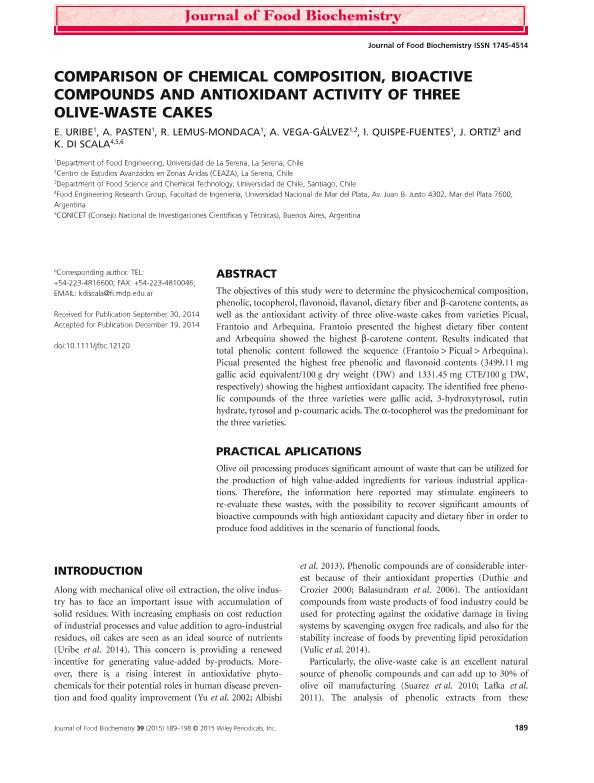Artículo
Comparison of Chemical Composition, Bioactive Compounds and Antioxidant Activity of Three Olive-Waste Cakes
Uribe, E.; Pasten, A.; Lemus Mondaca, R.; Vega Gálvez, A.; Quispe Fuentes, I.; Ortiz, J.; Di Scala, Karina Cecilia

Fecha de publicación:
04/2015
Editorial:
Wiley Blackwell Publishing, Inc
Revista:
Journal Of Food Biochemistry
ISSN:
0145-8884
Idioma:
Inglés
Tipo de recurso:
Artículo publicado
Clasificación temática:
Resumen
The objectives of this study were to determine the physicochemical composition, phenolic, tocopherol, flavonoid, flavanol, dietary fiber and β-carotene contents, as well as the antioxidant activity of three olive-waste cakes from varieties Picual, Frantoio and Arbequina. Frantoio presented the highest dietary fiber content and Arbequina showed the highest β-carotene content. Results indicated that total phenolic content followed the sequence (Frantoio>Picual>Arbequina). Picual presented the highest free phenolic and flavonoid contents (3499.11mg gallic acid equivalent/100g dry weight (DW) and 1331.45mg CTE/100g DW, respectively) showing the highest antioxidant capacity. The identified free phenolic compounds of the three varieties were gallic acid, 3-hydroxytyrosol, rutin hydrate, tyrosol and p-coumaric acids. The α-tocopherol was the predominant for the three varieties. Practical Aplications: Olive oil processing produces significant amount of waste that can be utilized for the production of high value-added ingredients for various industrial applications. Therefore, the information here reported may stimulate engineers to re-evaluate these wastes, with the possibility to recover significant amounts of bioactive compounds with high antioxidant capacity and dietary fiber in order to produce food additives in the scenario of functional foods.
Archivos asociados
Licencia
Identificadores
Colecciones
Articulos(CCT - MAR DEL PLATA)
Articulos de CTRO.CIENTIFICO TECNOL.CONICET - MAR DEL PLATA
Articulos de CTRO.CIENTIFICO TECNOL.CONICET - MAR DEL PLATA
Citación
Uribe, E.; Pasten, A.; Lemus Mondaca, R.; Vega Gálvez, A.; Quispe Fuentes, I.; et al.; Comparison of Chemical Composition, Bioactive Compounds and Antioxidant Activity of Three Olive-Waste Cakes; Wiley Blackwell Publishing, Inc; Journal Of Food Biochemistry; 39; 2; 4-2015; 189-198
Compartir
Altmétricas



